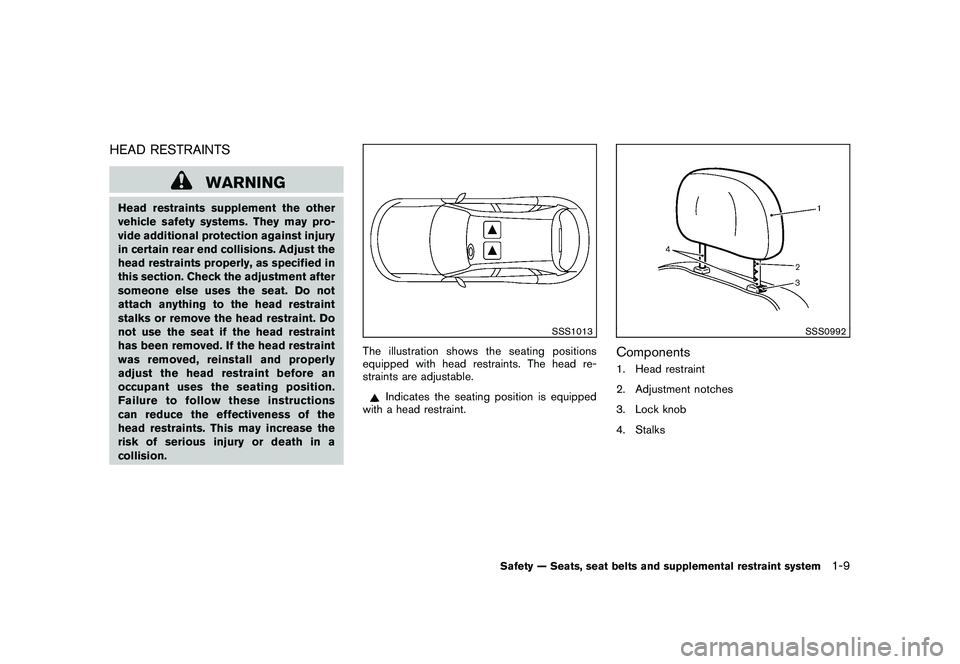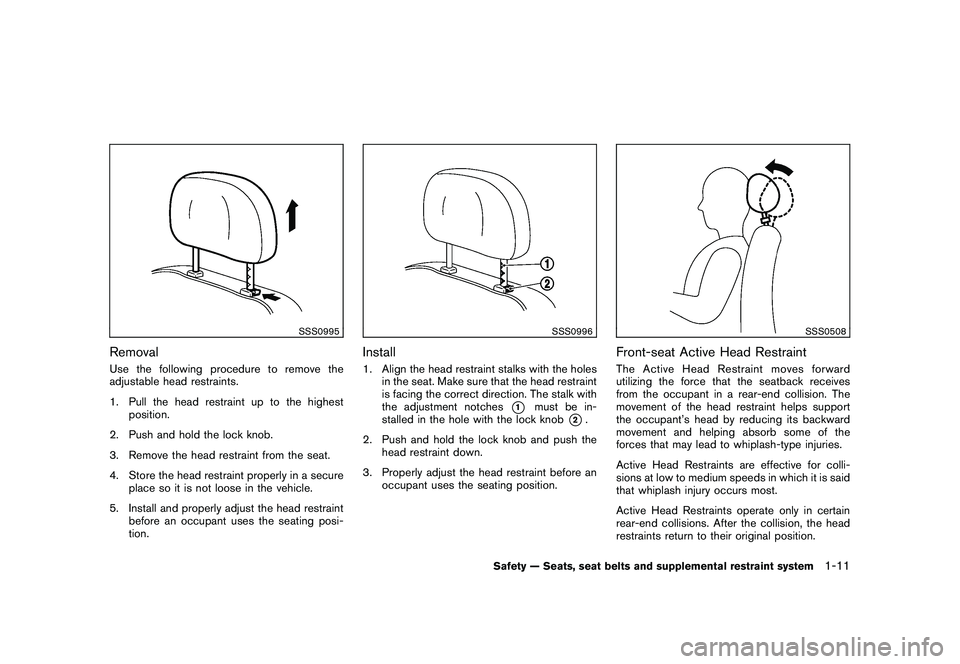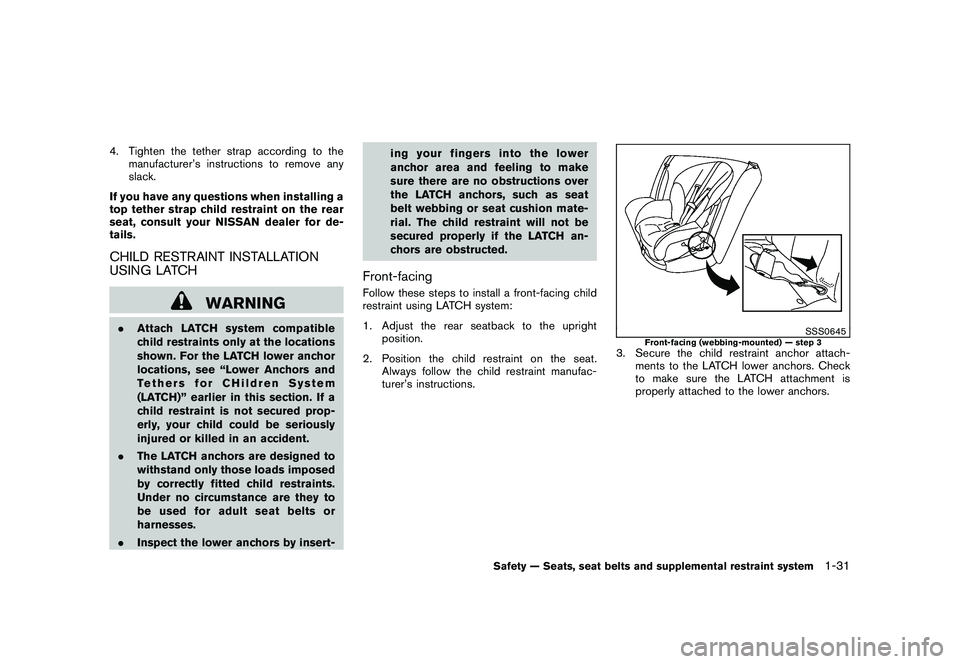2010 NISSAN MURANO remove seats
[x] Cancel search: remove seatsPage 24 of 425

Black plate (20,1)
Model "Z51-D" EDITED: 2009/ 8/ 3
SSS1028
Lumbar support (if so equipped):
The lumbar support feature provides lower back
support to the driver.
Push the front
*1
or back
*2
end of the switch
to adjust the seatback lumbar area.
SSS0569
REAR SEATS
FoldingBefore folding the rear seats:
. Secure the seat belts on the seat belt hooks
on the side wall. (See “Seat belt hooks” later
in this section.)
. Disconnect and stow the center seat belt
and tongue into the retractor base. (See
“Rear center seat belt” later in this section.)
. Always reconnect the center seat belt when
the seat is returned to the upright position.
. Remove drink containers from the rear cup
holder. To fold down the seatbacks:
Pull the strap on the rear seat
*A
. Pull the lever
*B
beside the cargo area and fold the seat-
back.
1-6
Safety — Seats, seat belts and supplemental restraint system
Page 27 of 425

Black plate (23,1)
Model "Z51-D" EDITED: 2009/ 8/ 3
HEAD RESTRAINTS
WARNING
Head restraints supplement the other
vehicle safety systems. They may pro-
vide additional protection against injury
in certain rear end collisions. Adjust the
head restraints properly, as specified in
this section. Check the adjustment after
someone else uses the seat. Do not
attach anything to the head restraint
stalks or remove the head restraint. Do
not use the seat if the head restraint
has been removed. If the head restraint
was removed, reinstall and properly
adjust the head restraint before an
occupant uses the seating position.
Failure to follow these instructions
can reduce the effectiveness of the
head restraints. This may increase the
risk of serious injury or death in a
collision.
SSS1013
The illustration shows the seating positions
equipped with head restraints. The head re-
straints are adjustable.
Indicates the seating position is equipped
with a head restraint.
SSS0992
Components1. Head restraint
2. Adjustment notches
3. Lock knob
4. Stalks
Safety — Seats, seat belts and supplemental restraint system
1-9
Page 29 of 425

Black plate (25,1)
Model "Z51-D" EDITED: 2009/ 8/ 3
SSS0995
RemovalUse the following procedure to remove the
adjustable head restraints.
1. Pull the head restraint up to the highestposition.
2. Push and hold the lock knob.
3. Remove the head restraint from the seat.
4. Store the head restraint properly in a secure place so it is not loose in the vehicle.
5. Install and properly adjust the head restraint before an occupant uses the seating posi-
tion.
SSS0996
Install1. Align the head restraint stalks with the holesin the seat. Make sure that the head restraint
is facing the correct direction. The stalk with
the adjustment notches
*1
must be in-
stalled in the hole with the lock knob
*2.
2. Push and hold the lock knob and push the head restraint down.
3. Properly adjust the head restraint before an occupant uses the seating position.
SSS0508
Front-seat Active Head RestraintThe Active Head Restraint moves forward
utilizing the force that the seatback receives
from the occupant in a rear-end collision. The
movement of the head restraint helps support
the occupant’s head by reducing its backward
movement and helping absorb some of the
forces that may lead to whiplash-type injuries.
Active Head Restraints are effective for colli-
sions at low to medium speeds in which it is said
that whiplash injury occurs most.
Active Head Restraints operate only in certain
rear-end collisions. After the collision, the head
restraints return to their original position.
Safety — Seats, seat belts and supplemental restraint system
1-11
Page 30 of 425

Black plate (26,1)
Model "Z51-D" EDITED: 2009/ 8/ 3
Adjust the Active Head Restraints properly as
described earlier in this section.ADJUSTABLE HEADREST
WARNING
The adjustable headrests supplement
the other vehicle safety systems. They
may provide additional protection
against injury in certain rear end colli-
sions. Adjust the headrests properly, as
specifiedinthissection.Checkthe
adjustment after someone else uses
the seat. Do not attach anything to the
adjustable headrest stalks or remove
the adjustable headrests. Do not use
the seat if the adjustable headrests
have been removed. If the headrest
was removed, reinstall and properly
adjust the headrest before an occupant
uses the seating position. Failure to
follow these instructions can reduce the
effectiveness of the adjustable head-
rests. This may increase the risk of
serious injury or death in a collision.
SSS1014
The illustration shows the seating positions
equipped with adjustable headrests. The head-
rests are adjustable.
Indicates the seating position is equipped
with an adjustable headrest.
SSS0992
Components1. Adjustable headrest
2. Adjustment notches
3. Lock knob
4. Stalks
1-12
Safety — Seats, seat belts and supplemental restraint system
Page 32 of 425

Black plate (28,1)
Model "Z51-D" EDITED: 2009/ 8/ 3
SSS0995
RemovalUse the following procedure to remove the
adjustable headrests.
1. Pull the headrest up to the highest position.
2. Push and hold the lock knob.
3. Remove the headrest from the seat.
4. Store the headrest properly in a secureplace so it is not loose in the vehicle.
5. Install and properly adjust the headrest before an occupant uses the seating posi-
tion.
SSS0996
Install1. Align the headrest stalks with the holes inthe seat. Make sure that the headrest is
facing the correct direction. The stalk with
the adjustment notches
*1
must be in-
stalled in the hole with the lock knob
*2.
2. Push and hold the lock knob and push the headrest down.
3. Properly adjust the headrest before an occupant uses the seating position.
SSS0229A
ARMREST
Rear armrestPull the armrest forward until it is horizontal.
1-14
Safety — Seats, seat belts and supplemental restraint system
Page 48 of 425

Black plate (44,1)
Model "Z51-D" EDITED: 2009/ 8/ 3
WARNING
.Child restraint anchor points are
designed to withstand only those
loads imposed by correctly fitted
child restraints. Under no circum-
stances are they to be used for adult
seat belts or harnesses.
. Your child could be seriously injured
or killed in a collision if the child
restraint top tether strap is da-
maged.
— If the cargo cover contacts the
top tether strap when it is at-
tached to the top tether anchor,
remove the cargo cover from the
vehicle or secure it on the cargo
floor below its attachment loca-
tion. If the cargo cover is not
removed, it may damage the top
tether strap during a collision.
— Do not allow cargo to contact the top tether strap when it is
attached to the top tether an-
chor. Properly secure the cargo
so it does not contact the top
tether strap. Cargo that is not
properly secured or that con- tacts the top tether strap may
damage the top tether strap
during a collision.
SSS0822
Top tether anchor point locationsAnchor points are located on the seatbacks.Installing top tether strapFirst secure the child restraint with the LATCH
system (rear outboard seating positions only) or
the seat belt as applicable.
1. Remove the headrest from the seatback.
Store it in a secure place.
2. Position the top tether strap over the top of the seatback.
3. Secure the tether strap to the tether anchor bracket that provides the straightest instal-
lation.
1-30
Safety — Seats, seat belts and supplemental restraint system
Page 49 of 425

Black plate (45,1)
Model "Z51-D" EDITED: 2009/ 8/ 3
4. Tighten the tether strap according to themanufacturer’s instructions to remove any
slack.
If you have any questions when installing a
top tether strap child restraint on the rear
seat, consult your NISSAN dealer for de-
tails.CHILD RESTRAINT INSTALLATION
USING LATCH
WARNING
. Attach LATCH system compatible
child restraints only at the locations
shown. For the LATCH lower anchor
locations, see “Lower Anchors and
Tethers for CHildren System
(LATCH)” earlier in this section. If a
child restraint is not secured prop-
erly, your child could be seriously
injured or killed in an accident.
. The LATCH anchors are designed to
withstand only those loads imposed
by correctly fitted child restraints.
Under no circumstance are they to
be used for adult seat belts or
harnesses.
. Inspect the lower anchors by insert- ing your fingers into the lower
anchor area and feeling to make
sure there are no obstructions over
the LATCH anchors, such as seat
belt webbing or seat cushion mate-
rial. The child restraint will not be
secured properly if the LATCH an-
chors are obstructed.
Front-facingFollow these steps to install a front-facing child
restraint using LATCH system:
1. Adjust the rear seatback to the upright
position.
2. Position the child restraint on the seat. Always follow the child restraint manufac-
turer’s instructions.
SSS0645
Front-facing (webbing-mounted) — step 3
3. Secure the child restraint anchor attach-ments to the LATCH lower anchors. Check
to make sure the LATCH attachment is
properly attached to the lower anchors.
Safety — Seats, seat belts and supplemental restraint system
1-31
Page 50 of 425

Black plate (46,1)
Model "Z51-D" EDITED: 2009/ 8/ 3
SSS0646
Front-facing (rigid-mounted) — step 3
4. The back of the child restraint should besecured against the vehicle seatback. If
necessary, adjust or remove the headrest
to obtain the correct child restraint fit. (See
“HEAD RESTRAINTS” earlier in this sec-
tion.)
If the headrest is removed, store it in a
secure place. Be sure to reinstall the
headrest when the child restraint is re-
moved.
If the seating position does not have an
adjustable headrest and it is interfering with
the proper child restraint fit, try another
seating position or a different child restraint.
SSS0647
Front-facing — step 5
5. For child restraints that are equipped withwebbing-mounted attachments, remove any
additional slack from the anchor attach-
ments. Press downward and rearward firmly
in the center of the child restraint with your
knee to compress the vehicle seat cushion
and seatback while tightening the webbing
of the anchor attachments.
6. If the child restraint is equipped with a top tether strap, route the top tether strap and
secure the tether strap to the tether anchor
point. (See “TOP TETHER STRAP CHILD
RESTRAINT” earlier in this section.)
SSS0638
Front-facing — step 7
7. After attaching the child restraint, test itbefore you place the child in it. Push it from
side to side while holding the seat near the
LATCH attachment path. The child restraint
should not move more than 1 inch (25 mm)
from side to side. Try to tug it forward and
check to see if the LATCH attachment holds
the restraint in place. If the restraint is not
secure, tighten the LATCH attachment as
necessary, or put the restraint in another
seat and test it again. You may need to try a
different child restraint. Not all child re-
straints fit in all types of vehicles.
1-32
Safety — Seats, seat belts and supplemental restraint system